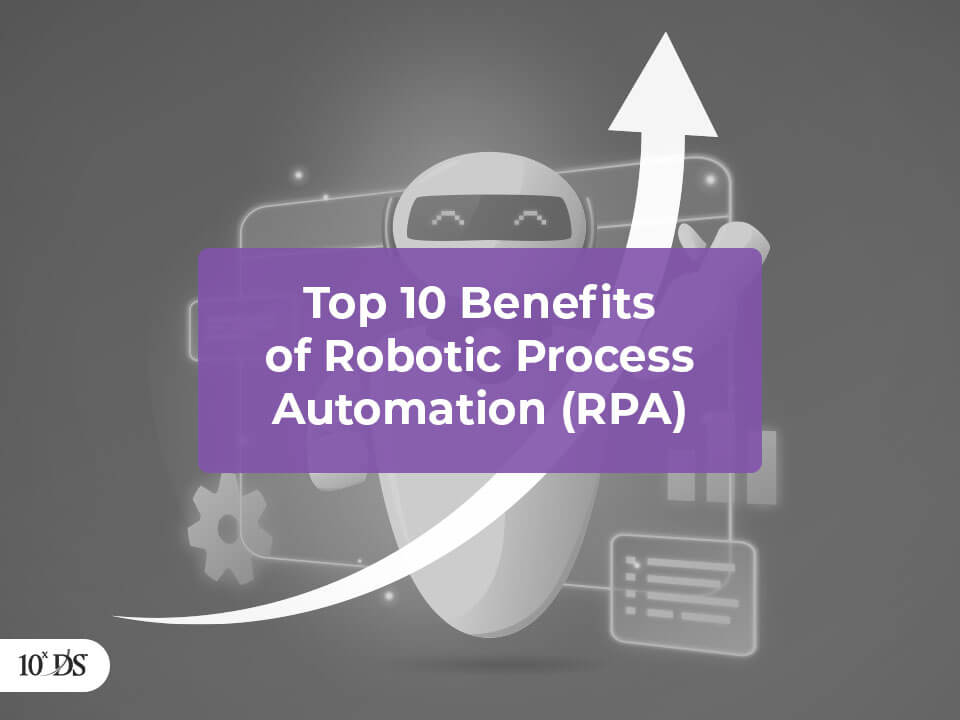
Top 10 Benefits of Robotic Process Automation (RPA)
The Economics of Robotic Process Automation (RPA) cannot be ignored any further, and its use in various industries, like all strategic moves, is about the intelligent use of resources. It frees the human employee from mundane, repetitive tasks and empowers them to concentrate on core business objectives instead, bringing about numerous benefits to the workplace. In fact, the benefits of RPA extend far beyond efficiency — they impact cost, accuracy, and scalability.
What is Robotic Process Automation?
Robotic process automation helps in the application of specific technologies that can automate mundane, routine, standardized tasks, creating higher productivity and value with lesser investment. Essentially, a computer software or ‘software bot’ is allowed to capture and interpret applications for processes that involve manipulating data, executing transactions, triggering responses, and communicating with other digital systems within the domain.
Among the advantages of RPA is its ability to streamline processes that previously relied on manual inputs, reducing errors and speeding up operations. This system is rapidly gaining popularity, predominantly in the banking and finance sectors due to the large volume of transactions and the great benefits of RPA that can be realized within a short time frame. The magnitude of the benefits of automation is directly proportional to the incremental improvement in the manual processing hotspots. The RPA platform provides your business with the scalability needed to stay, perform, and sustain at the top of your game. We have deployed RPA solutions in Dubai and around the world, helping enterprises accelerate digital transformation.
Read: What is Robotic Process Automation (RPA) – An Introduction
10 Proven Benefits of RPA for Businesses
Let us take a snapshot of some of the advantages of robotic process automation:
1. Cost-Effective
It has been estimated that using robotics cuts operational costs by as much as 25-50%. Robots can operate 24/7 and take no vacation compared to humans, who work 8/5 and have a pre-fixed number of annual leaves each year. Having robots take over some of the manually intensive work from humans could result in visible gains for the business. Automation can help you recover the cost within a short time span, and from then on, it’s all gains!
2. Accuracy & Quality
RPA offers improved services to processes that have a high probability of human error, thereby increasing accuracy. Robots are reliable, consistent, and do not tire when expected to work tirelessly. They also reduce re-works and improve output quality. The best part is that robots follow all rules precisely, producing 100% accuracy in results.
3. Consistency
Robotics is a safe, non-invasive technology that doesn’t interfere with the inherent systems and provides perfect consistency in performing activities across the board, every time.
4. Improved Analytics
Access to error-free, accurate data from various sources improves the quality of analytics, leading to better decision-making and improved process execution.
5. Increased Employee Productivity
By automating mundane tasks, RPA allows employees to focus more on client and customer interaction, relationship management, and other high-value activities where humans naturally excel.
6. Increased Customer Satisfaction
Better quality work with high accuracy and improved customer interaction leads to increased customer satisfaction, which positively impacts the business’s reputation.
7. Faster
Bots handle task execution quickly, allowing for a larger amount of work to be completed in a much shorter time. With automation, faster delivery and accuracy become standard.
8. Reconciliation from Multiple Systems
RPA enables the tallying of data and information from multiple systems, generating insights that help with process integration.
9. Versatility
RPA can be applied across industries and can perform a wide range of tasks. Any rule-based, repeatable process is a candidate for automation.
10. Better IT Support and Management
RPA enhances service desk operations and network monitoring, allowing companies to handle short-term spikes without needing to recruit or train extra staff.
Key Use Cases of RPA Across Various Domains
The advantages of RPA are not limited to just cost reduction or time savings. Here are five prominent use cases of RPA implementation across different sectors:
- Banking and Finance: In loan processing, RPA automates data validation and documentation, reducing the time it takes to process loans and improving accuracy.
- Healthcare: RPA streamlines patient onboarding by automating the registration and verification processes, reducing wait times, and improving patient experience.
- Retail: RPA is used for inventory management and order processing, automating stock level checks and ensuring timely replenishment of items, resulting in better customer service.
- Telecom: For handling high volumes of customer service queries, RPA automates issue categorization and resolution, speeding up customer response times and enhancing service efficiency.
- Manufacturing: In procurement, RPA automates the purchase order creation and approval processes, reducing human intervention and ensuring timely order placement.
Conclusion
As this advanced technology revolutionizes process efficiencies and boosts productivity across industries, RPA is changing the way businesses operate. The advantages of RPA include not only cost and time savings but also improved employee satisfaction, customer experience, and data accuracy. Analysts suggest that RPA is creating a parallel economy that connects to the physical economy, speeding up and optimizing knowledge work in a multitude of sectors.
Time for you to bring your business onboard and join the biggest change ever!


